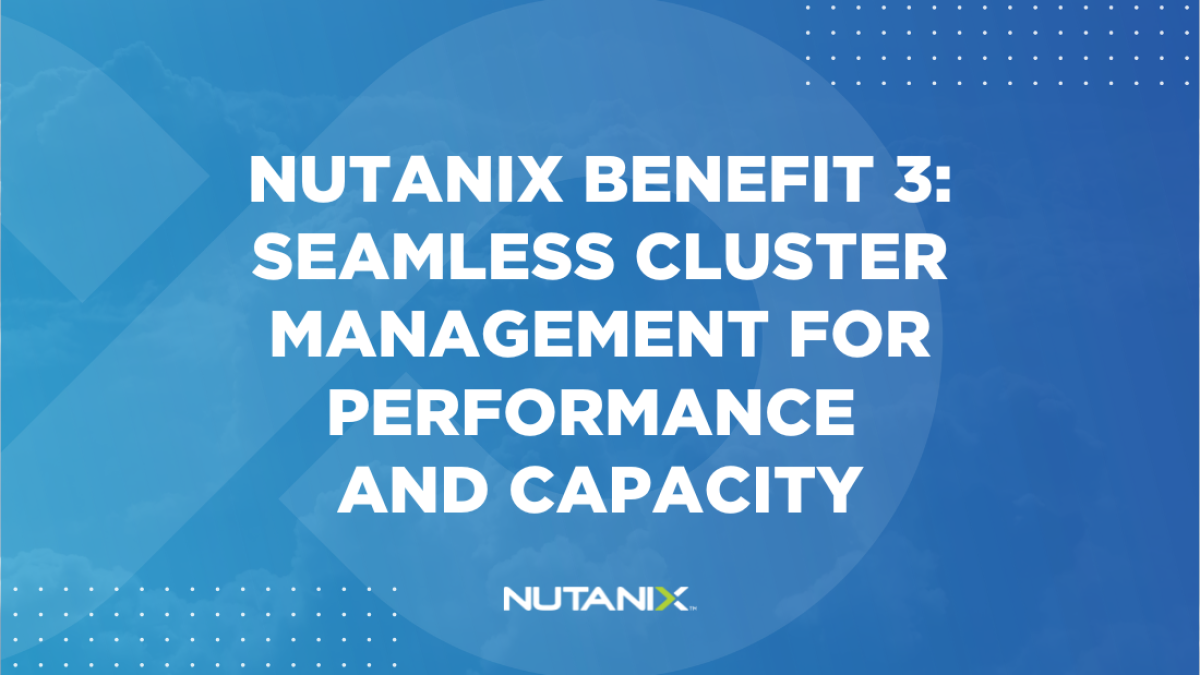In the first two blogs of this series, we discussed how Nutanix AOS provides dynamic distributed storage that enables automated app-aware data management. In this entry you’ll see how these two features have powerful benefits when administrators must expand their clusters by adding more physical nodes.
Cluster Management for Performance and Capacity
After deploying, day 2+ operations for infrastructure and applications become critical. Nutanix AOS makes life cycle management easy and seamless for administrators. An important task that all administrators must do is expand their infrastructure for storage or performance.
Administrators usually deploy a homogeneous cluster to start, but as applications grow, a common use-case is adding more capacity to the cluster. Administrators can choose to add multiple types of nodes including nodes with a higher storage capacity or a storage-only node which wouldn’t run application VMs. AOS makes this very simple because of its dynamic cloud architecture. Once a node is added, applications can instantly take advantage of the additional resources without any intervention unlike other HCI systems. This is made possible due to the fine-grained data that AOS writes, making dynamic and independent write decisions. AOS can automatically start using the new resources, writing copies to new nodes without manual intervention. Additionally, the Curator framework in AOS starts disk rebalancing through background operations, ensuring uniform usage of drives across the cluster, balancing the cluster automatically. See how adding a larger node benefits the cluster in the following example.
Not only can applications start using the capacity immediately, but when nodes are added, they also benefit from a performance standpoint . There is an immediate improvement in performance as applications can now distribute writes across the additional node in the cluster, improving write performance. From a compute perspective, if the nodes servicing the VMs were running hot, addition of new nodes would result in increased compute capacity for those existing nodes as new nodes would help in servicing replica writes, improving read and write latencies for those VMs. Since AOS does not use dedicated cache drives in its architecture, existing applications can instantly start reaping the benefits of added resources without manual configuration changes. Even while rebalancing for uniform capacity distribution, AOS algorithms minimize application performance impact by ensuring rebalancing background I/O does not overwhelm the front-end application.
Why Does This Matter?
With Nutanix, administrators don’t have to guess when planning for growth and expansion. AOS dynamically balances usage of resources based on capacity and performance, so administrators can easily have heterogeneous nodes like storage-only nodes running in the same cluster. This provides flexibility, depending on how the environment and application needs change. Flexible scalability also simplifies management, eliminating silos of infrastructure that would be required to maintain homogenous clusters. Automatic and immediate usage and rebalancing by AOS further reduces management time since administrators don’t have to carve out special maintenance windows during nights and weekends for growth of their environment. Finally, administrators can scale just in time based on application needs, no longer committing capital to procure gear that might sit unused in a box or rack or in some cases racked and using power but not providing value without manual intervention.
So far, we’ve seen howcloud principles and AOS architecture:
- Provides dynamic distributed storage, delivering resiliency and consistent performance
- Makes intelligent app-aware data placement and management decisions ensuring optimal performance for applications and quick recovery from failures
- Delivers seamless scaling of resources automatically for performance and capacity.
The above are important tenets of core AOS which form the foundation of primary data storage and management. All other Nutanix features are built on this strong foundation. Next, we’ll dive into how AOS natively provides granular and efficient snapshots enabling enterprise grade replication and multi-site disaster recovery for applications.

